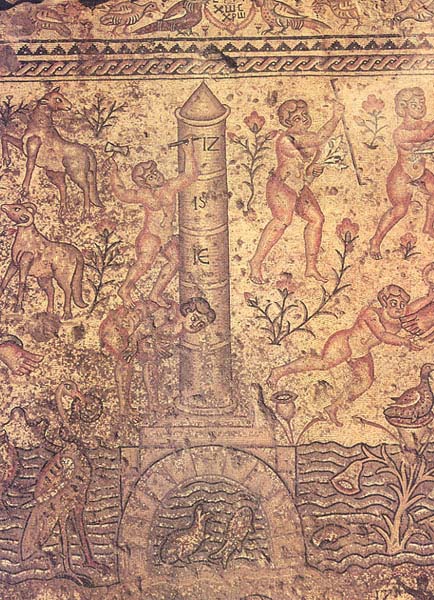
BAR readers know Sepphoris well. In the BAR 14:01 issue the mosaic known as the Mona Lisa of the Galilee appeared on the cover and was the prize find of the 1987 season.a More recently, in the BAR 18:03 issue, Sepphoris was the chief exhibit for a scholar’s contention that Jesus knew urban culture well—Sepphoris was a major urban center just an hour’s walk from Nazareeh.b
The finds at Sepphoris continue to dazzle—from the theater now fully exposed to the major public buildings and miqva’ot (ritual baths) to the magnificent mosaics. Indeed, the discovery of an extravagant new mosaic is the occasion for this report. The new mosaic covers the floor of a large, nearly square room (approximately 20 × 22 feet) and depicts an exotic scene along the Nile River in Egypt.
Sepphoris, Zippori in Hebrew, is located in the center of the Lower Galilee, three miles northwest of Nazareth. Although it was probably founded in First Temple days (eighth or seventh century B.C.E.) it reached its floruit much later. In the Hasmonean period (first century B.C.E.) as well as in the Herodian period (late first century B.C.E.–first century C.E.), Sepphoris served as the capital of the Galilee. Located on a prominent hill, overlooking the Netofa Valley astride two important highways (one from Akko [Ptolemais] to Tiberias and from there on to Transjordan; the other south to Nablus [Neapolis], Jerusalem and Hebron), Sepphoris was assured of an important commercial position. True, during the reign of Herod Antipas (4 B.C.E.–39 C.E.), hegemony temporarily shifted to Tiberias on the southwestern shore of the Sea of Galilee, but it soon returned to Sepphoris.

In the second century C.E., the city became a center of Jewish law and learning. At that time the Sanhedrin, the highest Jewish court, sat here. In about 200 C.E. here in Sepphoris, Judah ha-Nasi compiled the Mishnah, the earliest and most basic rabbinic text. According to the Talmud and the Mishnah many great sages lived here, teaching in the city’s numerous beth midrashim (houses of study). At this time, the city was also a commercial and agricultural center.
The first archaeological excavations at the site took place in 1931 under the direction of Leroy Waterman of the University of Michigan. He uncovered the theater and a few buildings. Since 1985 several extensive archaeological investigations have explored a large section of the hilltop. Between 1985 and 1989, an American-Israeli expedition from Duke University and the Hebrew University of Jerusalem dug cheek by jowl with an American team from the University of South Florida. During 1990 and 1991 excavation was continued by the Hebrew University under the direction of the authors.1
During these two seasons, we opened two new areas, one on the hilltop south of the Crusader-Turkish citadel and the other at the foot of the hill, on the southeastern side. In 1991 in an extension of the dig at the foot of the hill, we hit a large structure built of well-chiseled ashlars.c Most of the ashlars that were once there had been plundered in antiquity—doubtless for use in other buildings. The rooms in this ancient building, however, were all paved with mosaics, except for an area paved in stone that was probably an open courtyard.
The mosaics on most of the floors consisted of simple geometric designs or floral patterns, some in excellent condition. The largest of the rooms, however, contained a huge figurative mosaic with hunting scenes and a celebration on the banks of the Nile. The Nile flows through the center of the floor, pouring Out of the mouth of an animal near the top of the scene. A smaller stream winds its way down through the hunting scenes at the bottom of the mosaic. The Nile is richly decorated with its natural flora and fauna. Along its banks are a fisherman with his fishing net, a stork with a snake as prey in its mouth and a bird perched on a lotus flower. A fish swims down the river.
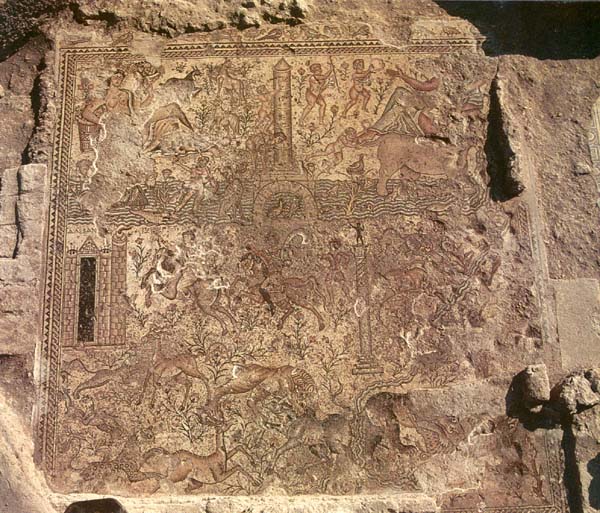
Above the Nile is a Nilometer set on a rectangular structure with an arched opening facing the river. The Nilometer measured the height of the water. This determined the tax rate for that year. The higher the water, the higher the tax. As the fifth-century B.C.E. Greek historian Herodotus said, “Egypt is the gift of the Nile.” When the Nile flows heavily and floods, the crops grown on the fields along the river are abundant. When it doesn’t, there may be a famine.
Nilometers were built at many sites along the river, usually beside temples. One Nilometer has actually been found near Alexandria, but mostly we know them from pictures. In practice, the Nilometers were set in square or round pits dug out beside the river. In depictions, however, the artist wanted to emphasize the height of the water, which would not be possible if the Nilometer were placed in a pit. Thus, the Nilometer was customarily portrayed as a round, towerlike pillar on which signs and numbers appeared.
The Nilometer on the Sepphoris mosaic is marked with horizontal lines with the numbers 16, 15, and 17—15, 16 and 17—between the lines. These numbers refer to the height of the water in cubits. Beside the Nilometer, a man holding a hammer and chisel stands on a woman’s back in order to get sufficient height to engrave the number IZ (17).
Depictions of Nilometers have been found at two other sites in Palestine—the house of Leontis in Beth-Shean and the Church of the Multiplication of the Loaves and Fishes at Tabgha on the shore of the Sea of Galilee.2 At Beth-Shean, the numbers on the Nilometer are 10, 11, 12, 13, 14, 15, 16; at Tabgha they are 6, 7, 8, 9 and 10. We have not yet been able to explain the difference.
Other Nilometers are known from mosaics elsewhere. They have even been found on coins, textiles and other small objects. Usually, however, any people near the Nilometer do not relate to it. The Sepphoris mosaic is rare in that the man is actually engraving the number on the Nilometer. So far as we have been able to tell, the only other example of a person engraving a number on a Nilometer is on a silver bowl in the Hermitage Museum in St. Petersburg (formerly Leningrad).
In each of the upper corners of the Sepphoris mosaic is a large reclining figure, one male and the other female. The female figure on the left personifies Egypt, as the Greek inscription AIGY[PYOS] above it indicates. Her robe covers only her back and feet, leaving her upper body exposed. Part of her body has been destroyed, we don’t know how. Her right elbow leans on a basket of fruit; in her left hand, she holds a cornucopia brimming with fruit.
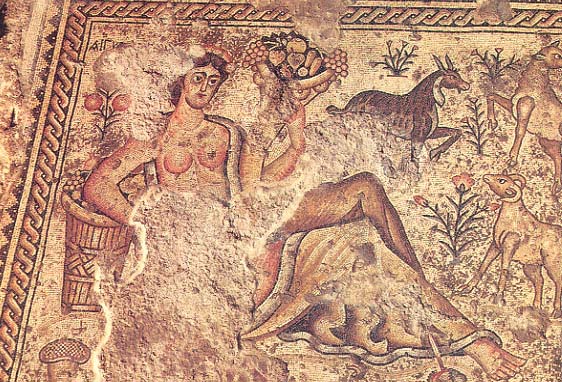
In the upper right corner is a male figure personifying the Nile. He is seated on an animal from whose mouth the waters of the Nile issue. His arms are outstretched toward two male nudes bearing gifts. One of these figures carries a wreath in one hand and a bird in the other. The second holds a staff used for measuring land; in his other hand he too holds a leafy wreath. An additional figure, also nude but this time female, supports the foot of the Nile god with one hand and presents him with a wreath with her other hand.
Beneath the Nile, we see the festivities celebrating the Nile’s annual high tide.
On the right is a column with a Corinthian capital and an attic base surmounted by a statue of a man. In one hand he holds a sword, in the other, a torch. Beside the torch the number IZ is inscribed, just as it is at the top of the Nilometer.
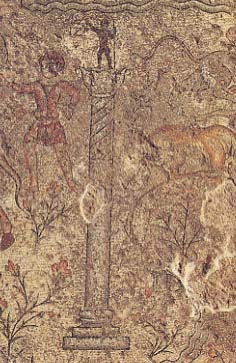
The number IZ appears again beside two horsemen who are depicted to the left of the column. The first horseman carries a torch—or perhaps a bouquet of flowers. A tunic-clad lad watching the horsemen appears behind them.
The procession is heading to Alexandria to bring the good news. Alexandria is represented by a city gate between two round towers. The name Alexandria appears above the city gate. To the right of the city gate and attached to it in the mosaic is an additional, even taller round tower. A flame at the top of this tower indicates that it represents the Pharos, the famous lighthouse of Alexandria, one of the seven wonders of the ancient world.
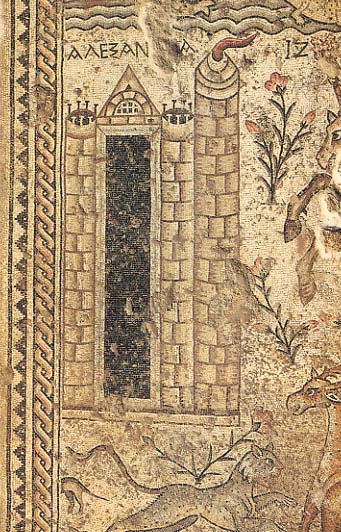
These representations of Alexandria and the Pharos suggest the possibility that the pillar with a statue in the mosaic may also depict an actual monument in that city. In the third century C.E., a monument known as the Pompeii Column was dedicated in Alexandria to the emperor Diocletian; in the early 1700s, it was uncovered in excavations near the Serapeum Temple in Alexandria. The column, surmounted by a Corinthian capital, apparently once held a colossal statue. The column in the Sepphoris mosaic may represent this monument.
The area to the right of this column and the lower section of the mosaic are dedicated to various hunting scenes, including depictions of a lion devouring a bull, a bear attacking a wild pig and a panther pouncing on a deer. Some of the victims appear in pairs, in which case one is attacked while the other stands by. The entire mosaic carpet is framed by a strip of stepped pyramids, and within it the common guilloche pattern of intertwined bands.
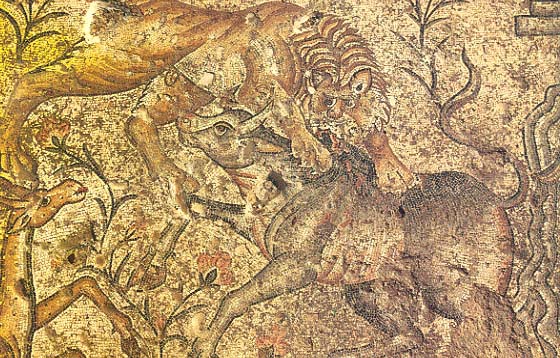
A row of birds, with a Greek inscription in the center, decorates the top of the mosaic. The inscription, “Use With Good Fortune,” appears in a wreath held in the beaks of two birds.
The Nile scene and the hunting scene are beautifully integrated in a way rare in Roman-Byzantine mosaic art. The artist approached the design quite freely with a most pleasing result. The figures are placed in a way that enables the viewer to understand the different subjects depicted. The entire mosaic is characterized by movement and even humor. In one vignette, as a leopard attacks two mice, one escapes through the edge of the mosaic.
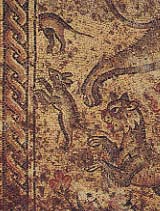
The freedom of composition, combining the Nile celebration with hunting scenes, can be contrasted with the organization of the mosaic discovered earlier at Sepphoris, a Dionysian scene which contains the Mona Lisa of the Galilee. In it, each picture is presented within a frame. This style was popular from the early Hellenistic period (c. third century B.C.E.) and continued to be characteristic of Roman mosaics until the fourth century C.E. During the fifth century, however, mosaic art in the East underwent a change. Mosaic artists began to conceptualize the floor (or the picture) as a whole. The separate panels disappear. Instead we find wide pictures, without internal borders, moving in all possible directions. The Nile Celebration mosaic differs from the Dionysian mosaic not only in subject matter, but also in composition. Our Nile Celebration mosaic stylistically resembles a group of mosaics found in Antioch, Apamea, Beirut and other cities of the Hellenistic-Roman East. Not only the technical organization of the floor but also the composition of the figures, and especially the hunting scenes, strongly link our Nile Celebration mosaic to this eastern group of mosaics. Our Nile mosaic therefore dates in all probability to the fifth or sixth century C.E.
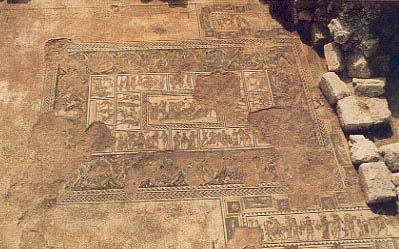
The existence of such a mosaic at Sepphoris indicates that the city may have been a center of the mosaic-floor industry during the Roman and Byzantine periods. It also suggests that the city continued to thrive in this period.
Another mosaic was found in a room south of this one, but we have not yet finished excavating it. So far, we have uncovered a centaur (half man and half horse) rearing up while holding a shield or dish with a Greek inscription: “Helpful God” (
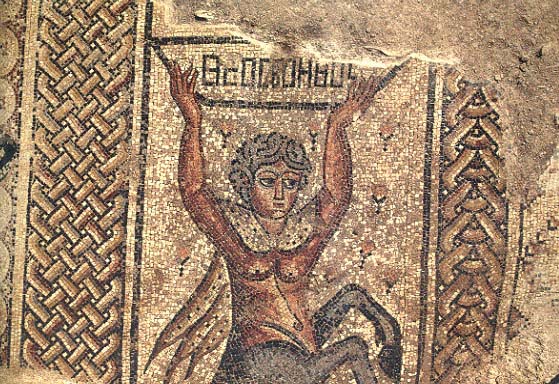
The building in which these mosaics were found was probably a public building rather than a private home. Further excavations may shed light on its function.
West of this building, we found remnants of a wide main road paved with hard, rectangular limestones. The worn pavement is marked by many carriage tracks from its use during the fifth and sixth centuries C.E. Jewish sources speak of Sepphoris as a flourishing agricultural trading center; they tell of markets both in the upper city and in the lower city. The remnants of this elaborate road and the markings of the heavy carts on the pavement make this reality tangible.
Beside the road, remnants of a stylobate (foundations for a row of pillars) and of a mosaic floor hint at a stoa, or covered colonnade. Stoas once may have existed on either side of the road. A road paved with stones flanked by colonnades paved with mosaics was common during this period. Examples have been found at Caesarea Maritima, Beth-Shean and Ephesus.
The road leads to the area where the South Florida expedition has been uncovering a large public building. The area we opened at the top of the hill was less dramatic, but no less interesting to the archaeologist. In one room we found two small amphorae, one of which was still closed with a pine-cone stopper. A number of additional articles were also found in a burnt layer: a complete bronze oil lamp with a cover, and with a bird perched on the handle; a miniature bronze statue of a lioness; and a small bronze cross—evidence of a Christian presence in Sepphoris. Three crosses were also found carved into the ashlars of a nearby building. Other finds included a tunnel that may have been part of Sepphoris’ drainage system. The burnt layer in which the small finds were found dates to the seventh century C.E. The fire could be connected with the Persian conquest of 614 C.E. or the Arab conquest that ended the Byzantine period in 640 C.E. Or it could be the result of an earthquake. But what all these relatively late finds demonstrate is that Sepphoris continued to be an important and wealthy city right up to the end of the Byzantine period. Until our last two seasons of excavation, the archaeological evidence seemed to indicate, contrary to the literary sources, that Sepphoris declined in the Byzantine period. Now we know that this was not the case. The earlier conclusion was based on excavations on the summit of the hill. Now, in light of these recent results, it is clear that during the Byzantine period, Sepphoris was larger, more magnificent and prosperous than we had thought. On the top of the hill, it is true, building was sparse during this period. The focus of the city lay, however, on the slopes of the hill, and mainly in the saddle-shaped area in the east. The continuation of excavations in this area, east of the hilltop, may expose the center of the city from the Mishnaic and talmudic period when it was a center of learning and commerce and was built in Roman architectural style. This city apparently continued into the Byzantine period. Little by little ancient Sepphoris is coming to light.

